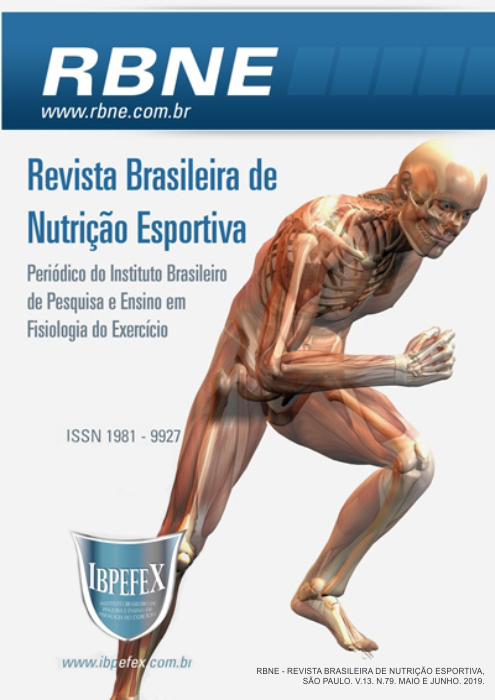Is there relation between hand grip and body composition in Shotokan Karate high level athletes?
Abstract
Introduction: In Karate's movements, there is a predominance of those performed by the upper body members. Body composition and mainly the muscular development, are associated with force generation, which is associated with faster and explosives movements, determinative factor in competitive fights. Objective: Analysis the relation between body composition and handgrip strength in mankind Karate high level athletes. Methods: For this research, 21 mankind Karate athletes of Kumite (fight modality) from the Project São Paulo Olímpico from Federação Paulista de Karate (FPK) participated. Results: The athletes disclosed an average of 24.5 (7.6) years; 77.6 (9.6) Kg; 25.3 (2.3) Kg/m²; and a body fat percentage of 17.7 (3.5). The handgrip strength was an average of 80.5 (12.2) Kgf. Conclusion: The results obtained in this study points medium-strong positive correlation (r=0.65) between the variable amount proposed, pointing the importance of the study of its relation and appliance in nutritional, physical and yield monitoring, purposing to increase performance.
References
-ACSM American College of Sports Medicine -ACSM. Manual para avaliação da aptidão física relacionada à saúde. Rio de Janeiro. Guanabara Koogan. 2006.
-Andreato, L.V.; Moraes, S.M.F.; Gomes, T.L.M.; Esteves, J.V.D.C.; Andreato, T.V.; Franchini, E. Estimated aerobic power, muscular strength and flexibility in elite Brazilian Jiu-Jitsu athletes. Science & Sports. Vol. 26. Núm. 6. p. 329-337. 2011.
-Beneke, R.; Beyer, T.; Jachner, C.; Erasmus J.; Hütler, M. Energetics of karate kumite. European Journal of Applied Physiology. Vol. 92. Núm. 4-5. p. 518-523. 2004. Disponível em: <http://dx.doi.org/10.1007/s00421-004-1073-x>.
-Caporrino, F.A.; Faloppa, F.; Santos, J.B.G.; Réssio, C; Soares F.H.C.S; Nakachuma, L.R.; Segre, N.G. Estudo populacional da força de preensão palmar com dinamômetro Jam. Revista Brasileira de Ortopedia. Vol. 33. Núm. 33. p. 150-154. 1998.
-Caputo, E.L.; Silva, M.C.; Rombaldi, A.J. Comparação entre diferentes protocolos de medida de força de preensão manual. Rev. Educ. Fís/UEM. Vol. 25. Núm. 3. p. 481-487. 2014.
-Deminice, R.; Rosa, F.T. Pregas cutâneas vs impedância bioelétrica na avaliação da composição corporal de atletas: uma revisão crítica. Rev Bras Cineantropom Desempenho Hum. Vol. 3 Núm. 11. p. 334-340. 2008.
-De Lorenzo, A.; Bertini, I.; Iacopino, L.; Pagliato, E.; Testolin, C.; Testolin, G. Body composition measurement in highly traines male athletes: A comparison of three methods. J Sports Med Phys Fitness. Vol. 40. p.178-183. 2000.
-Francescato, M.P.; Talon, T.; Prampero, P.E. Energy cost and energy sources in karate. Eur J Appl Physiol. Vol. 71. p. 355-361. 1995.
-Imamura H.; Yoshimura, Y.; Uchida, K.; Tanaka, A.; Nishimura, S.; Nakazawa, A.T. Heart Rate, Blood Lactate Responses and Ratings of Perceived Exertion to 1000 Punches and 1000 Kicks in Collegiate Karate Practitioners. Applied Human Science: Journal of Physiological Antropology. Vol. 1. Núm. 16. p. 9-13. 1996.
-Jackson, A.S.; Pollock, M.L. Generalized equation for predicting body density of men. Br J Nutr. Vol. 40. p. 497-504. 1978.
-Lima, M.C.; Kubota, L.M.; Monteiro, C.B.M.; Baldan, C.S.; Pompeu, J.E. Força de preensão manual em atletas de judô. Rev Bras Med Esporte. Vol. 20. Núm. 3. p. 210-213. 2014.
-Lohman, T.G.; Roche A.F.; Martoreli R. Anthropometric standardization reference manual. Illinois: Human Kinetics Books, 1992.
-Motulsky, H. Intuitive biostatistics. 1st ed. New York: Oxford University Press. 1995.
-Organização Mundial de Saúde-OMS. Obesidade: prevenindo e controlando a epidemia global. São Paulo. Roca. 2004.
-Reis, V.A.B.; Azevedo, C.O.E.; Rossi, L. Perfil antropométricoe taxa de sudorese no futebol juvenil. Rev Bras Cineantropom Desempenho Hum. Vol. 11. p. 134-141. 2009.
-Rossi, L. Antropometria. In: Rossi, L. Nutrição em academias: do Fitness ao Wellness. São Paulo. Roca. 2015.
-Rossi, L.; Tirapegui, J. Avaliação antropométrica de atletas de Karatê. Revista Brasileira de Ciência e Movimento. Vol. 3. Núm. 15. p. 39-46. 2007.
-Rossi, L.; Caruso, L.; Galante, A.P. Avaliação nutricional: novas perspectivas. São Paulo. Roca. 2015.
-Rossi, L.; Tirapegui, J.; Castro, I.A. Restrição moderada de energia e dieta hiperprotéica promovem redução ponderal em atletas de elite do Karatê. R. bras. Ci e Mov. Vol. 12. Núm. 2. p. 69-73. 2004. 20-Silva, B.V.C.; Júnior, M.M.; Lopes, C.R.; Mota, G.R. Brazilian jiu-jitsu: aspectos do desempenho. Revista Brasileira de Prescrição e Fisiologia do Exercício. Vol. 6. Núm. 31. p. 57-64. 2012.
-Schwartz, J.; Takito, M.Y.; Bullet, F.; Vecchio, F. Health-related physical fitness in martial arts and combat sports practitioners. Sport Sciences For Health. Vol. 11. Núm. 2. p.171-180. 2015.
Authors who publish in this journal agree to the following terms:
- Authors retain the copyright and grant the journal the right of first publication, with work simultaneously licensed under the Creative Commons Attribution License BY-NC which allows the sharing of the work with acknowledgment of the authorship of the work and initial publication in this journal.
- Authors are authorized to enter into additional contracts separately for non-exclusive distribution of the version of the work published in this journal (eg, publishing in institutional repository or book chapter), with acknowledgment of authorship and initial publication in this journal.
- Authors are allowed and encouraged to post and distribute their work online (eg, in institutional repositories or on their personal page) at any point before or during the editorial process, as this can bring about productive change as well as increase impact and impact. citation of published work (See The Effect of Free Access).






